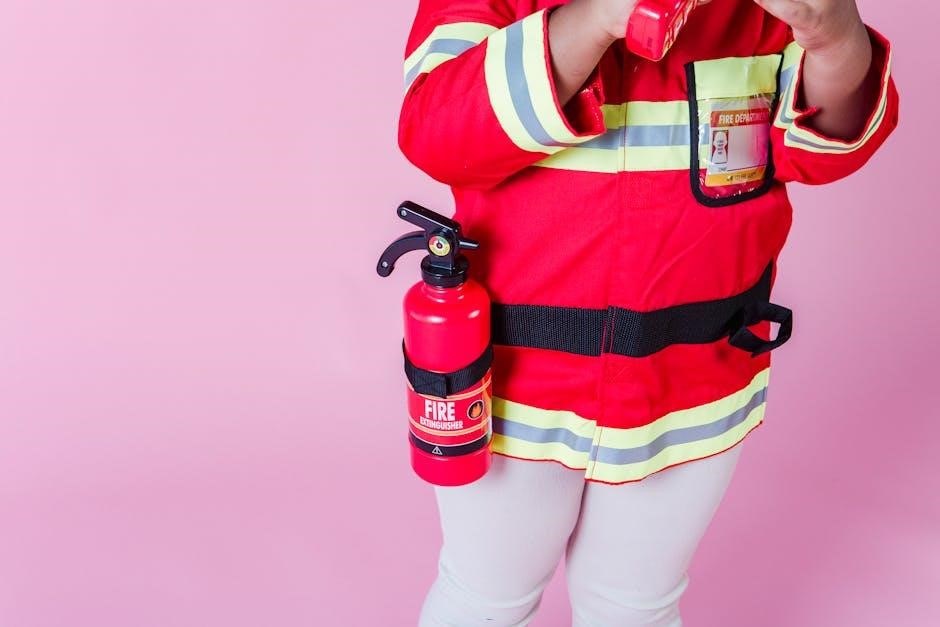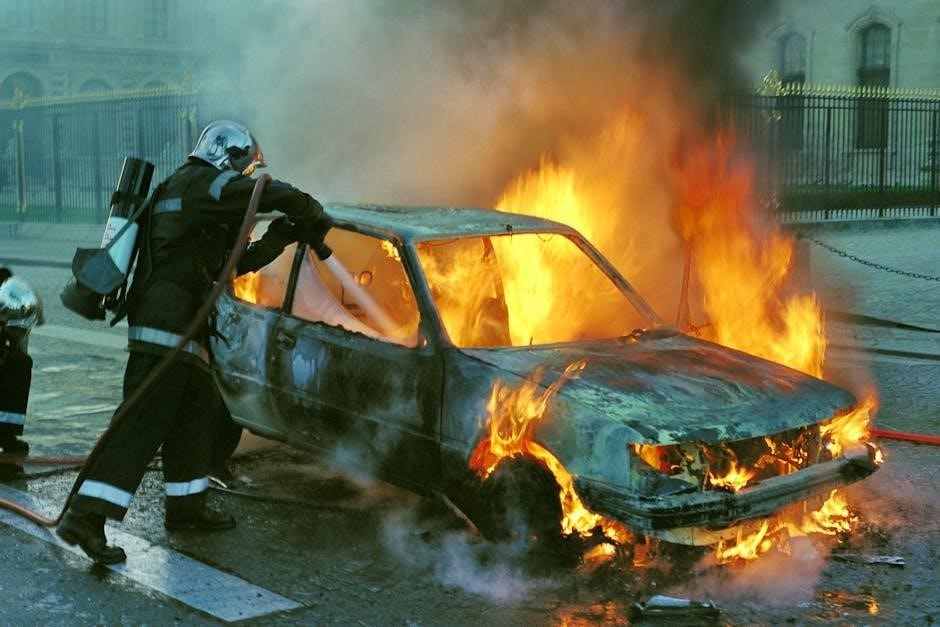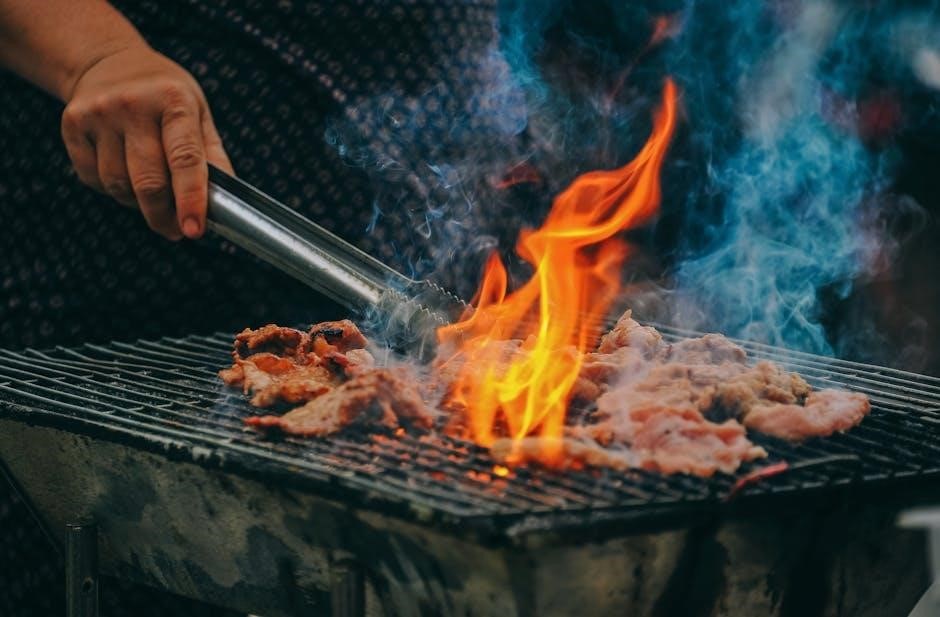
Fire extinguishers are vital for immediate response to fires, preventing escalation and safeguarding lives and property. They come in various types to effectively combat different fire classes, ensuring effective and safe fire control in emergencies.
Importance of Fire Extinguishers in Safety
Fire extinguishers play a critical role in ensuring safety by providing an immediate response to fires, preventing their spread, and protecting lives and property. They are essential in various settings, from homes to workplaces, as they empower individuals to act swiftly during emergencies. Properly selected and maintained extinguishers can minimize damage, reduce risks, and save lives. Their presence is a fundamental component of fire safety protocols, offering a first line of defense before professional help arrives. By understanding and using the right extinguisher for specific fire types, individuals can effectively control or extinguish fires in their early stages, preventing escalation and ensuring a safer environment for everyone.
Overview of Fire Extinguisher Types
Fire extinguishers are categorized into several types, each designed to address specific fire hazards. The primary types include water-based, dry chemical powder, foam, carbon dioxide (CO2), wet chemical, halon, and clean agent extinguishers. Each type works differently, targeting distinct fire classes such as Class A (combustible solids), Class B (flammable liquids), Class C (electrical fires), and Class K (cooking oils and fats). Multi-purpose ABC extinguishers are versatile for multiple fire classes; The choice of extinguisher depends on the environment, such as homes, offices, or industrial settings. Understanding these types ensures effective fire control and safety, preventing escalation and reducing risks. Proper selection and use are critical to combating fires safely and efficiently.

Classification of Fires
Fires are categorized into classes based on the fuel source, such as solids, liquids, gases, electrical, metals, and cooking oils, to determine appropriate extinguishing methods.
Class A Fires: Combustible Solids
Class A fires involve combustible solids such as wood, paper, cloth, and plastics. These fires are common in households and workplaces, often starting from ordinary materials igniting due to heat or sparks. Water-based extinguishers are highly effective for Class A fires, as they cool the burning material, removing heat from the fire triangle. Additionally, multi-purpose ABC dry chemical extinguishers can also be used, as they smother the fire and prevent reignition. It is crucial to avoid using water on electrical fires, as it can conduct electricity and cause harm. Class A fires are typically the most manageable with the right extinguisher, making them a priority in fire safety training and preparedness.
Class B Fires: Flammable Liquids
Class B fires involve flammable liquids such as petrol, oil, grease, alcohol, and paint. These fires can spread quickly and are highly dangerous due to the volatile nature of the substances involved. The primary goal in extinguishing Class B fires is to smother the flames and prevent re-ignition. Suitable extinguishers for Class B fires include foam, dry chemical powder, and carbon dioxide (CO2) types. Foam extinguishers are particularly effective as they create a barrier between the fuel and oxygen, while CO2 extinguishers are ideal for electrical fires involving flammable liquids. It is crucial to avoid using water-based extinguishers on Class B fires, as water can cause the fire to spread further. Always ensure the extinguisher is rated for Class B fires before attempting to tackle the blaze.
Class C Fires: Electrical Fires
Class C fires involve electrical equipment, such as wiring, circuits, or appliances. These fires are hazardous due to the risk of electric shock and reignition. Water-based extinguishers are unsafe for Class C fires, as water conducts electricity, increasing danger. Instead, dry chemical or carbon dioxide (CO2) extinguishers are recommended. Dry chemical extinguishers smother the fire by interrupting the chemical reaction, while CO2 extinguishes by displacing oxygen. Both types are non-conductive and safe for electrical fires. Always ensure the extinguisher is rated for Class C fires to prevent further hazards and electrical complications. Proper training is essential to handle such fires safely and effectively.
Class D Fires: Combustible Metals
Class D fires involve combustible metals such as magnesium, sodium, or aluminum. These fires are highly hazardous and require specialized extinguishing methods. Unlike other fire classes, water should never be used on Class D fires, as it can cause violent reactions or spread the fire. Dry powder extinguishers are specifically designed for Class D fires, as they smother the flames and prevent oxygen from reaching the combustible metals. These extinguishers are often labeled as “D-rated” and contain agents like graphite or sodium chloride. Proper training is essential to handle such fires safely and effectively. Using the wrong extinguisher can worsen the situation, making it critical to identify the fire class before acting.
Class K Fires: Cooking Oils and Fats
Class K fires involve cooking oils and fats, commonly occurring in commercial kitchens. These fires are hazardous due to their high temperatures and tendency to reignite. Wet chemical fire extinguishers are specifically designed for Class K fires, as they cool the oil and create a barrier to prevent oxygen from reaching the flames. Unlike water or dry chemical extinguishers, wet chemicals are safe for use on cooking oils, preventing dangerous splashes and ensuring effective fire control. Proper training is essential for handling these fires, as incorrect methods can worsen the situation. Regular maintenance of kitchen fire extinguishers is crucial to ensure readiness in emergencies.

Types of Fire Extinguishers
Fire extinguishers are categorized by their extinguishing agents and mechanisms. Common types include water, dry chemical, foam, CO2, wet chemical, Halon, clean agent, and multi-purpose ABC extinguishers.
Water-Based Fire Extinguishers
Water-based fire extinguishers are one of the most common types, primarily designed to combat Class A fires, which involve combustible solids like wood, paper, and cloth. These extinguishers work by removing heat from the fire, effectively starving it of one of the essential elements needed to sustain combustion. They are simple, cost-effective, and widely used in residential and commercial settings. However, water-based extinguishers are not suitable for electrical fires or flammable liquids, as they can worsen the situation. It’s crucial to use them only in appropriate scenarios to ensure safety and effectiveness. Regular maintenance is recommended to guarantee proper functioning when needed.
Dry Chemical Powder Extinguishers
Dry chemical powder extinguishers are versatile and widely used for combating Class B (flammable liquids) and Class C (electrical) fires. They work by smothering the fire and interrupting the chemical reaction, effectively halting combustion. These extinguishers are ideal for industrial and commercial settings due to their broad applicability. However, they are less effective on Class A fires (combustible solids) and may leave a residue, requiring thorough cleanup after use.
Their multi-purpose nature makes them a popular choice for general fire risks. They are not recommended for Class K fires (cooking oils) or environments where residue-free suppression is critical. Regular maintenance is essential to ensure their reliability in emergencies.
Foam Fire Extinguishers
Foam fire extinguishers are designed to combat Class A and Class B fires, effectively smothering flames by cutting off oxygen supply. They are ideal for environments with flammable liquids or solids. The foam creates a barrier, preventing re-ignition and cooling the fuel. Commonly used in warehouses, garages, and industrial settings, foam extinguishers are versatile. However, they are unsuitable for electrical fires due to conductivity risks. Regular maintenance ensures reliability in emergencies. Proper training is essential for effective use. Foam extinguishers are a key component in fire safety strategies, offering reliable protection against specific fire hazards. Their effectiveness in controlling and extinguishing fires makes them a valuable tool in fire management systems. Always select the right type based on fire class for optimal safety.
Carbon Dioxide (CO2) Fire Extinguishers
Carbon dioxide (CO2) fire extinguishers are highly effective for Class B (flammable liquids) and Class C (electrical) fires. They work by displacing oxygen, starving the fire of the oxygen it needs to burn, and cooling the surrounding area. CO2 extinguishers leave no residue, making them ideal for protecting sensitive electrical equipment and documents. However, they are not suitable for Class A fires (combustible solids) as they do not cool the fuel sufficiently to prevent re-ignition. Use in confined spaces requires caution due to the risk of oxygen displacement, which can be hazardous to people; These extinguishers are commonly used in laboratories, data centers, and areas with electrical equipment or flammable liquids.
Wet Chemical Fire Extinguishers
Wet chemical fire extinguishers are specifically designed for Class K fires, involving cooking oils and fats, and are also effective on Class A fires. They contain a potassium-based agent that smothers the fire and cools the fuel, preventing reignition. These extinguishers are ideal for commercial kitchens and areas with deep fryers or cooking equipment. They are not suitable for Class B or C fires, as they may not effectively address flammable liquids or electrical hazards. Wet chemical extinguishers are preferred in high-risk cooking environments due to their rapid fire suppression and cooling properties, making them a critical component of kitchen fire safety systems. Regular maintenance is essential to ensure their reliability in emergencies.
Halon Fire Extinguishers
Halon fire extinguishers are highly effective for Class B (flammable liquids) and Class C (electrical) fires. They work by displacing oxygen and breaking the chemical combustion chain, leaving no residue. Ideal for protecting sensitive equipment, they are commonly used in data centers, labs, and museums. However, Halon is harmful to the ozone layer, leading to its phase-out under international agreements. While still available in some systems, eco-friendly alternatives like clean agents are now preferred. Always avoid using Halon on Class A fires or solid materials, as it is ineffective and dangerous in such cases. Proper training is essential for safe and effective use of Halon extinguishers in emergencies.
Clean Agent Fire Extinguishers
Clean agent fire extinguishers are highly effective for Class B (flammable liquids) and Class C (electrical) fires. They use electrically non-conductive agents that leave no residue, making them ideal for sensitive environments like data centers, laboratories, and electronics facilities. Unlike traditional methods, clean agents suppress fires by displacing oxygen and cooling the area without damaging equipment. They are favored for their quick action and minimal cleanup requirements. These extinguishers are particularly useful in scenarios where electrical equipment is at risk, as they do not conduct electricity and ensure safe operation. Their versatility and efficiency make them a popular choice for protecting valuable assets in modern facilities.
Multi-Purpose ABC Fire Extinguishers
Multi-Purpose ABC fire extinguishers are versatile and designed to combat fires involving ordinary combustibles, flammable liquids, and electrical equipment. They utilize a dry chemical agent that interrupts the chemical chain reaction, effectively smothering the fire. These extinguishers are widely used in commercial and residential settings due to their broad applicability. They are particularly effective for Class A, Class B, and Class C fires, making them a popular choice for general fire safety. However, they are not suitable for Class D or Class K fires. Regular maintenance is essential to ensure proper functioning, as the dry chemical can become compacted over time, reducing effectiveness. Their ease of use and wide-range applicability make them a cornerstone in fire safety preparedness.

Fire Extinguisher Uses by Fire Class
Fire extinguishers are matched to fire classes to ensure safe and effective fire control. Class A fires use water-based extinguishers, while Class B and C fires require dry chemical or foam extinguishers.
Class A Fires: Suitable Extinguishers
Class A fires involve combustible solids such as wood, paper, cloth, and plastics. These fires are typically extinguished using water-based fire extinguishers, as water effectively removes heat from the burning materials. Water extinguishers are the most common choice for Class A fires due to their simplicity and effectiveness. Additionally, multi-purpose ABC extinguishers can also be used, as they are designed to handle Class A, B, and C fires. Wet chemical extinguishers are another option, especially for larger or more intense Class A fires, as they provide better penetration and cooling properties. It is crucial to avoid using extinguishers not designed for Class A fires, such as carbon dioxide or dry chemical powder, as they may not effectively control the fire.
Class B Fires: Recommended Extinguishers
Class B fires involve flammable liquids or gases, such as petrol, oil, or propane. These fires require extinguishers that can smother the fuel and cool the surrounding area. Dry chemical powder extinguishers are highly effective for Class B fires, as they create a barrier between the fuel and oxygen. Foam extinguishers are also suitable, as they blanket the surface, preventing vapors from igniting. Carbon dioxide (CO2) extinguishers are ideal for electrical fires involving flammable liquids, as they displace oxygen without causing electrical hazards. It’s crucial to avoid using water, as it can spread the fire. Always ensure the extinguisher is rated for Class B fires and follow proper usage techniques to maintain safety and effectiveness.
Class C Fires: Safe Extinguishing Methods
Class C fires involve electrical equipment, such as appliances, wiring, or circuits. These fires are particularly hazardous due to the risk of electric shock and reignition. Water-based extinguishers should never be used on Class C fires, as they conduct electricity and can cause severe injury or death. Instead, dry chemical powder or carbon dioxide (CO2) extinguishers are recommended, as they do not conduct electricity and effectively smother the fire by removing oxygen. Always ensure the power source is disconnected before attempting to extinguish a Class C fire, if safe to do so. Additionally, evacuate the area and call professional firefighters if the fire is large or spreading rapidly.
Class D Fires: Specialized Extinguishers
Class D fires involve combustible metals such as magnesium, aluminum, or titanium, requiring specialized extinguishers. Unlike other fire classes, water exacerbates these fires, making dry powder or sodium chloride-based extinguishers essential. These agents smother the fire by starving it of oxygen and cooling the metal. Proper training is critical, as improper use can lead to dangerous reactions. Always ensure the extinguisher is rated for Class D fires to effectively manage and prevent reignition. Safety precautions include avoiding water-based extinguishers and ensuring the fire is fully extinguished to prevent re-ignition risks. Specialized equipment is vital for controlling these unique and hazardous fires.
Class K Fires: Wet Chemical Extinguishers
Class K fires involve cooking oils and fats, commonly occurring in commercial kitchens. Wet chemical extinguishers are specifically designed for these fires, as they effectively smother the flames and cool the fuel, preventing re-ignition. Unlike other extinguisher types, wet chemical agents create a barrier between the oil and oxygen, ensuring thorough extinguishing. These extinguishers are ideal for deep fat fryers and cooking equipment. They are a critical safety tool in environments where cooking oils are used, providing reliable protection against potentially dangerous Class K fires. Proper training is essential for their safe and effective use in emergency situations.

How to Choose the Right Fire Extinguisher
Selecting the correct fire extinguisher involves assessing fire risks, understanding fuel types, and matching extinguisher ratings to specific fire classes for effective and safe fire control.
Assessing Fire Risks in Different Environments
Evaluating fire hazards in various settings is crucial for selecting the right fire extinguishers. Residential, commercial, and industrial environments have unique risks. For instance, kitchens may require wet chemical extinguishers for cooking oils, while offices might need multi-purpose ABC extinguishers for general use. Industrial spaces, with flammable liquids or electrical equipment, may demand dry chemical or CO2 extinguishers. Understanding the types of fires likely to occur in each environment ensures proper preparedness. Factors like the presence of electrical devices, flammable materials, and hazardous chemicals guide extinguisher selection. A thorough risk assessment helps prevent fires from escalating and ensures safety. Always match extinguisher types to potential fire classes for effective fire control and to avoid dangerous situations;
Matching Extinguisher Types to Fire Classes
Correctly matching fire extinguisher types to fire classes is crucial for effective fire control. Class A fires (combustible solids) are best handled with water or multi-purpose extinguishers. Class B fires (flammable liquids) require dry chemical, foam, or carbon dioxide extinguishers to smother the fuel. Class C fires (electrical) demand non-conductive agents like dry chemical or CO2 to avoid electrical hazards. Class D fires (combustible metals) need specialized dry powder extinguishers to starve the fire of oxygen. Class K fires (cooking oils) are effectively managed with wet chemical extinguishers. Using the wrong type can exacerbate the fire, making proper selection essential for safety and efficiency.

Safety Precautions for Using Fire Extinguishers
Always assess the situation before using an extinguisher. Ensure you are trained, the fire is small, and the area is clear for safe evacuation.
Use the PASS method: Pull the pin, Aim the nozzle, Squeeze the handle, and Sweep the discharge. Never use the wrong extinguisher type for the fire class.
When to Use a Fire Extinguisher
A fire extinguisher should only be used when the fire is small, contained, and does not pose an immediate threat to safety. Ensure the extinguisher is suitable for the fire class and that you are trained in its proper use. Always maintain a safe escape route and avoid using an extinguisher in a confined space without ventilation. Do not attempt to fight a fire if it is spreading rapidly or if you are unsure of the fire type. Using the wrong extinguisher or improper technique can worsen the situation. Remember, fire extinguishers are a first line of defense to control or extinguish fires in their early stages, not to fight large, unmanageable blazes.
When Not to Use a Fire Extinguisher
A fire extinguisher should not be used if the fire is too large or spreading rapidly, as it may be unsafe to attempt to control it without professional help. Never use the wrong type of extinguisher for the fire class, as this can worsen the situation or cause explosions. For example, water extinguishers should not be used on electrical or flammable liquid fires. Additionally, if the extinguisher is not fully charged or malfunctioning, it should not be relied upon. Always prioritize safety; if in doubt, evacuate the area and call emergency services. Using an extinguisher improperly can lead to injury or escalate the fire, so it’s crucial to use them only in appropriate situations and with proper training.

Maintenance and Inspection of Fire Extinguishers
Regular checks and inspections ensure extinguishers function properly in emergencies. Inspections verify pressure, damage, and accessibility. Neglecting maintenance can lead to safety risks and legal consequences.
Regular Checks for Proper Functioning
Regular inspections of fire extinguishers are crucial to ensure they are ready for immediate use in emergencies. Start by checking the extinguisher’s pressure gauge to confirm it is within the recommended range. Inspect the hose and nozzle for any signs of damage or blockages. Verify that the locking mechanism is intact to prevent unauthorized use; Ensure the extinguisher is easily accessible and not obstructed by furniture or other objects. Check for any visible signs of corrosion or leaks on the cylinder or valves. Finally, log the inspection date on the extinguisher’s inspection tag and schedule professional maintenance annually to guarantee optimal functionality. Neglecting these checks can lead to malfunction, increasing fire risks and potential hazards.
Refilling and Recharging Procedures
Refilling and recharging fire extinguishers require precision to ensure optimal functionality. Only trained professionals should perform these tasks, adhering to manufacturer guidelines and safety standards. Inspect the extinguisher for damage or wear before refilling. Use approved agents and propellants, ensuring compatibility with the extinguisher type. Pressure testing is critical for certain types, like CO2 or water-based extinguishers, to verify cylinder integrity. After refilling, recharge the extinguisher to the recommended pressure level. Detailed records should be maintained, including the date and type of service performed. Proper storage and regular inspections are essential to maintain readiness. Always follow local fire safety regulations to guarantee compliance and effectiveness. Regular maintenance ensures fire extinguishers remain reliable in emergencies.
Key Takeaways on Fire Extinguisher Types and Uses
Understanding fire extinguisher types and their correct usage is crucial for effective fire management. Always match extinguishers to fire classes and ensure regular maintenance for reliability.
Final Thoughts on Fire Safety Preparedness
Proper fire extinguisher selection and maintenance are vital for safeguarding lives and property. Stay prepared to prevent and control fires efficiently in any situation.
Understanding the correct types of fire extinguishers and their uses is crucial for effective fire management. Different fire classes—A, B, C, D, and K—require specific extinguishers to ensure safety and efficiency. Water extinguishers are ideal for Class A fires involving combustible solids, while dry chemical powder extinguishers are suitable for Class B and C fires. Foam extinguishers work well for Class A and B fires, but not electrical ones. Carbon dioxide extinguishers are best for Class C fires, and wet chemical extinguishers are designed for Class K fires. Always match the extinguisher type to the fire class to avoid dangerous reactions. Proper training and maintenance are essential to ensure extinguishers function correctly in emergencies.
Proper fire safety preparedness is essential for minimizing risks and ensuring effective response to emergencies. Understanding fire extinguisher types and their appropriate uses is crucial for everyone. Regular training, inspections, and maintenance of fire extinguishers ensure they are ready when needed. Always prioritize safety by selecting the right extinguisher for the specific fire class. Remember, fire safety is a collective responsibility, and being prepared can save lives and property. Stay informed, stay vigilant, and ensure all safety measures are in place to handle potential fires effectively.